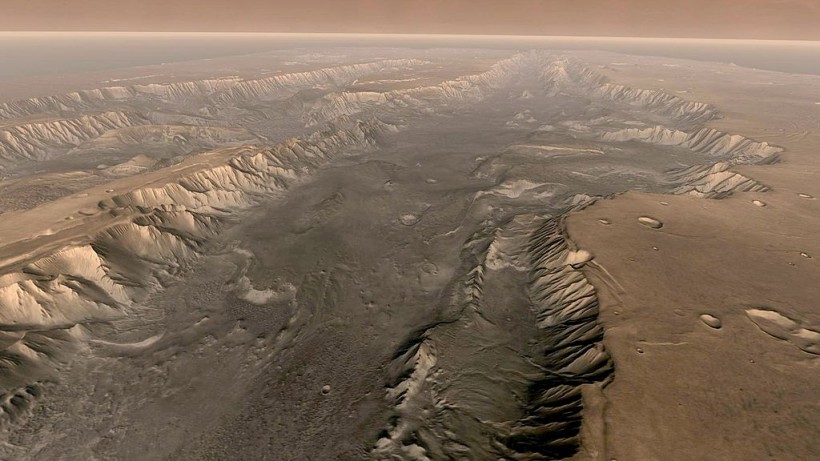NASA's InSight lander experienced two massive "marsquakes" that originated near the Martian equator in an area known as the Cerberus Fossae.

VALLES MARINERIS, MARS - Mars' own Grand Canyon, Valles Marineris, is shown on the surface of the planet in this composite image made aboard NASA's Mars Odyssey spacecraft. The image was taken from a video featuring high-resolution images from Arizona State University's Thermal Emission Imaging System multi-band camera onboard the spacecraft. The mosaic was then colored to approximate how Mars would look to the human eye. Valles Marineris is 10 times longer, five times deeper, and 20 times wider than Earth's Grand Canyon.
The quakes, which had magnitudes of 3.1 and 3.3 on March 7 and March 18, solidify Cerberus Fossae's status as one of Mars' most geologically active areas. In 2019, a pair of similarly powerful marsquakes shook the same region.
A series of huge, nearly parallel fissures scar the Cerberus Fossae zone, created when the planet's crust was torn open by a dramatic volcanic event. The main cause of quakes on Mars is volcanism since the Red Planet lacks the tectonic plates that cause much of the quakes we experience on Earth.
The Cerberus Fossae field on Mars is one of the main epicenters of such activity, and it's a fascinating area to research due to its geological instability, both in the past and now.
What Does the Discovery of Marsquakes Mean?
In a statement, NASA said InSight has reported over 500 marsquakes after its November 2018 deployment to Mars.
The four powerful quakes reported in Cerberus Fossae on Mars, on the other hand, showed that the area is the epicenter of the Red Planet's seismic activity.
The finding paves the way for the InSight research team to progress their quest to grasp Mars' mantle and heart better.
While Mars does not have tectonic plates like Earth, it has been discovered to have volcanic activity, creating tremors.
ALSO READ: NASA InSight Lander Says Mars Molten Core Has A Whooping 1800-km Radius!
Taichi Kawamura of France's Institut de Physique du Globe de Paris said they have seen 'more Moon-like' and 'more Earth-like' marsquakes throughout the mission.
Another interesting fact is that the latest marsquakes happened nearly a full Martian year (two Earth years) with magnitudes of 3.6 and 3.5, respectively.
The marsquakes occurred during the northern summer on Mars - where the winds are calmer - making it easier for the equipment to detect the tremors.
Geologists expected the InSight to hear quakes from the Cerberus Fossae area six years before the spacecraft arrived on Mars. A research team examined the field in 2012 using images from the Mars Reconnaissance Orbiter's HiRISE camera and found evidence of recent landslides as well as boulders that had rolled down the steep slopes of some of the chasms (Possible evidence of paleomarsquakes from fallen boulder populations, Cerberus Fossae, Mars).
These rockslides appeared to be consistent with earthquake aftershocks here in the United States, implying that a marsquake may have occurred recently. The new detections from InSight support this theory.
InSight Mission's History
NASA gave the InSight mission a two-year extension in January, during which time the team hopes to compile a comprehensive record of Martian seismic activity. They've started burying the SEIS instrument's cable with the lander's robotic arm to ensure the best possible quality data. Wind noise, waves, and temperature fluctuations, both of which can interact with the seismometer and mask potential marsquake detections, would be reduced as a result.
Universe Today said InSight usually struggles with dust-covered solar panels. Hence, some of the lander's instruments - such as its weather station - would have to be switched off for the time being. SEIS will be able to run for another month or two thanks to Insight's remaining capacity, after which it will have to go into hibernation as well. This low-power state will last until the panels are washed by a dust devil or until Mars' orbit takes it closer to the Sun, which should happen soon after July.
Meanwhile, scientists are excited by the Cerberus Fossae quake detections and conclude that more powerful quakes are on the way. The inSight will be able to communicate with the planet's mantle and heart if it hears a "Large One." We will discover more about the planet's internal structure from listening to such a case, something we actually know very little about.
RELATED ARTICLE: NASA Declares Mars Digger Defunct After Failing to Burrow Into Planet
Check out more news and information on Space on Science Times.










!['Cosmic Glitch' in Einstein's Theory of General Relativity Could Be Explained in This New Scientific Tweak [Study]](https://1721181113.rsc.cdn77.org/data/thumbs/full/53435/258/146/50/40/cosmic-glitch-in-einsteins-theory-of-general-relativity-could-be-explained-in-this-new-scientific-tweak-study.jpeg)



